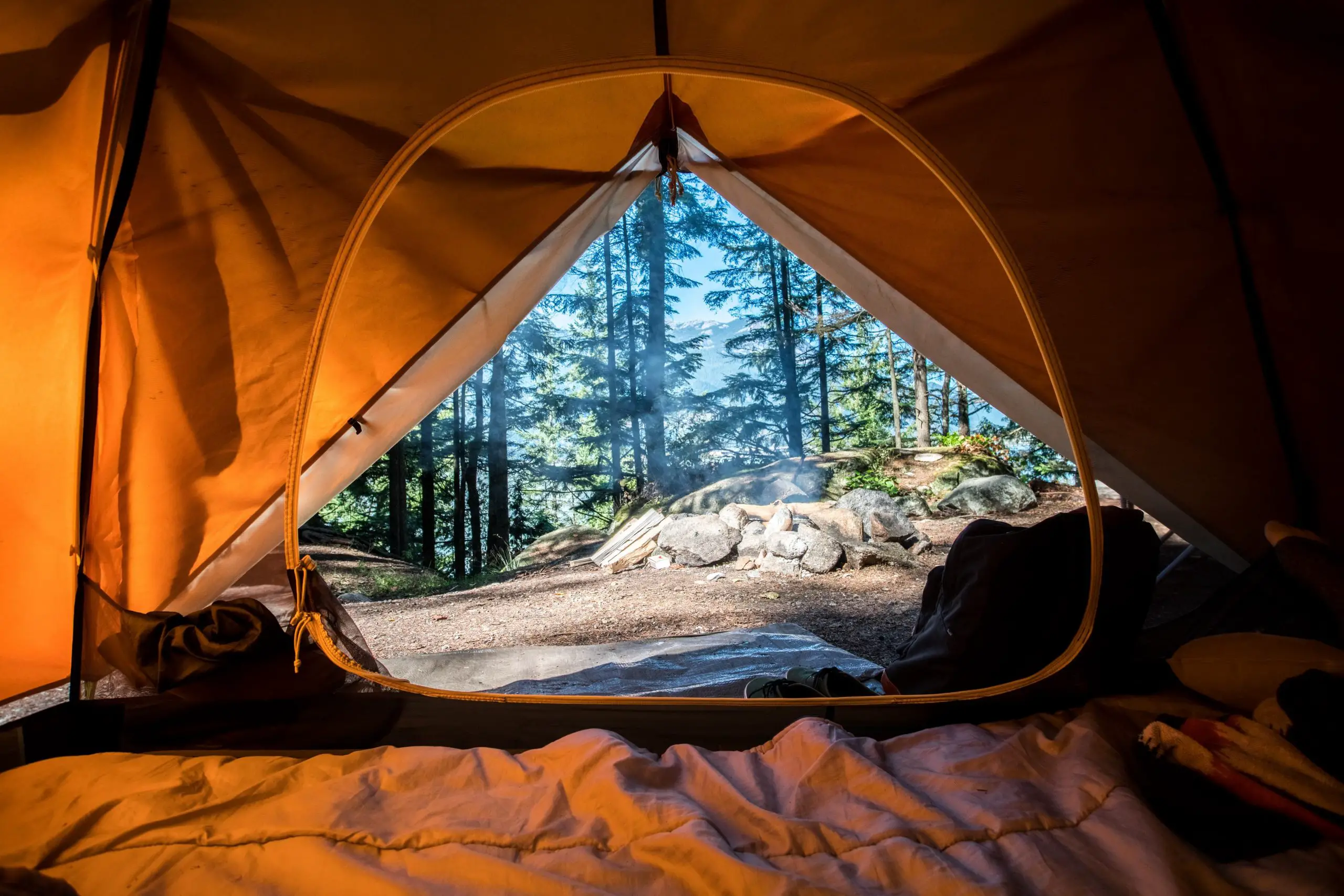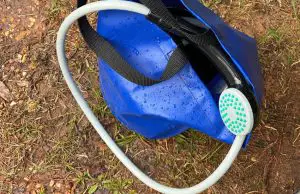Why You Should Put A Tarp Under Your Tent

Camping with a tent is pretty much a give-in. There could be clear skies one minute and rain the next, which is why it is we often bring tents along. So where do tarps come in?
The function of a tarp under your tent is similar to a tent footprint. So in other words, a tarp can be used under the tent to provide an extra layer of protection for your tent, keeping it dry and free from mud and debris.
Aside from that, placing a tarp under your tent has many other benefits. Keep reading to find out!
Quick Links
Is A Tarp Under Your Tent Necessary?
It’s not entirely necessary. Depending on the terrain and weather of your trip, you may or may not need one. If you’re planning on camping in an area with a lot of rocks and roots, then a tarp might give you some extra peace of mind. If the ground is really wet or you expect rain, then a tarp is also a good idea to keep your sleeping area dry.
Secondly, it also depends on your tent. The higher the quality of your tent, the less necessary a tarp is. However, cheaper tents will definitely benefit from an extra layer of protection.
However, if you want to extend the life of your tent no matter the quality, then we recommend using a tarp. We’ve seen some pretty nasty weather conditions while camping and placing a tarp under our tent has definitely saved our gear on more than one occasion. So while it’s not necessary, it’s certainly a great idea. Without further ado, let’s discuss some more of the benefits below.
Benefits Of Putting a Tarp Under Your Tent
A tarp affords you and your camping tent numerous benefits. Here are a few reasons and benefits for placing a tarp under your tent.
Serves as Insulation
Unless you enjoy the feeling of cold, moist grass – then, by all means, don’t use a tarp.
Otherwise, a tarp placed under your tent can help to insulate you from the cold ground. In the colder months, especially, this is a great way to stay warm and comfortable throughout the night.
Prevents Moisture and Dirt
Most tarps are water-resistant, but not fully waterproof. So how does it help prevent moisture?
Well, for one it will protect the bottom of the tent from any moisture that may be building up from the outside. Secondly, it will help to keep condensation from building up on the INSIDE of your tent overnight, and that’s especially true if you live in an area with high humidity.
As an added bonus, a tarp also helps keep your sleeping area clean by preventing dirt and debris from getting on your tent floor.
Reduces Noise
If you’re planning on camping in an area with a lot of foot traffic, then a tarp is a great way to reduce noise. Believe it or not, the tarp will help muffle footsteps and other sounds, making it easier for you to sleep through the night.
Protection From Punctures And Bugs
A tarp placed under your tent will help protect the bottom of your tent from any sharp objects that might puncture it. This is especially important if you’re camping on rocky terrain. And let’s face it, no matter how smooth the ground looks, there’s always the potential for sharp or jagged objects.
Secondly, a tarp placed under your tent will also help protect you from bugs. No one likes waking up to a bunch of creepy crawlies in their sleeping area. Tarps can act as sort of a barrier, keeping those pesky insects out.
Increases Longevity Of Your Tent
As we mentioned before, a tarp placed under your tent will help increase the lifespan of your tent — no matter the quality. If you want to get the most use out of your tent, then using a tarp is a great way to do so.
No matter how tough or durable your tent is, the bottom will always be susceptible to wear and tear. A tarp placed under your tent will help to protect the bottom from any abrasion, making it last longer.
How To Choose The Right Tarp?
Now that we’ve discussed some of the benefits of using a tarp under your tent, let’s talk about how to choose the right one. After all, not all tarps are created equal. Here are a few factors to consider when choosing a tarp for your next camping trip.
Size
The first thing you need to consider is the size of the tarp. Obviously, you’ll want to make sure that the tarp is large enough to cover the entire area of your tent — plus a little extra. That way, you can be sure that your entire tent and sleeping area are protected. But you don’t want it TOO big. Aim for slightly larger than your tent – large enough to have a small fold on the outside edges of the tent so water doesn’t build up.
Material
The next thing you need to consider is the material of the tarp. Most tarps are made from either polyethylene or canvas. Canvas is a bit more durable and will last longer, but it’s also more expensive. Polyethylene is more affordable but not as durable.
Weight
Another thing to consider is the weight of the tarp. If you’re planning on backpacking or hiking to your campsite, then you’ll want to choose a tarp that’s light enough to carry. But if weight isn’t an issue, then you can opt for a heavier tarp — like canvas, which is more durable.
Which Type of Tarp Should I Use?
There are several options available, and knowing the right one for your tent is the first step in the right direction.
- Tent Footprints: This is an expensive ground cloth designed by manufacturers with dimensions fitted to a particular tent. This ground cloth offers you moisture control and production. However, the degree of this protection varies with the quality of the footprint and the tent.
- Classic Multi-Purpose Tarp: Unlike a tent footprint, the classic multi-purpose tarp is more economical and budget-friendly. It is also more versatile as you can use it for a variety of purposes other than just protecting your tent. You can use it as an improvised shelter, or even as a sunshade. Multi-purpose tarps are available in different sizes, so make sure you get one that will fit your tent well.
- Tyvek Ground Cloth: Tyvek ground cloths offer you good puncture and tear resistance. They are also light and compact, which makes them ideal for backpacking. However, they don’t offer much in terms of moisture protection.
- Polycro Ground Cloth: Polycro ground cloths are made of a clear plastic material that is lightweight and compact. They offer good moisture protection and are also budget-friendly. However, they don’t offer much in terms of puncture or tear resistance.
How Do I Setup A Tarp Under Tent Correctly
Knowing how to actually place your tarp under your tent is more important than the quality or type of tarp you get. After all, a poorly set-up tarp can actually do more harm than good. Here are a few tips to help you set up your tarp correctly.
Choose The Right Spot
The first step is to choose the right spot for your tent. You’ll want to make sure that the spot is level and free of any sharp objects that could puncture your tent. You’ll also want to make sure that the area is clear of any overhanging branches or other potential hazards.
Clear The Area
Once you’ve chosen the spot for your tent, it’s time to clear the area. This means removing any rocks, sticks, or other debris that could damage your tent. You should also clear a path around the perimeter of your tent so that you can easily access it. If you’re using a ground cloth, make sure to clear an area for that as well.
Set Up The Tarp
Now it’s time to set up the tarp. Start by finding the center point of the tarp and placing it under the center of your tent. Then, stake down the corners of the tarp so that it doesn’t move. Once the tarp is in place, you can start setting up your tent.
Make Sure It Doesn’t Stick Out
This is probably the most important part of setting up a tarp under your tent. Make sure that the tarp doesn’t stick out from under your tent. If your tarp is exposed and rolled upwards, it’s going to end up catching rain and funneling it straight under your tent. This is the last thing you want, so make sure to tuck in any excess tarp material.
Stake It Down
Once the tarp is in place, you’ll want to stake it down so that it doesn’t move. This is especially important if you’re expecting high winds. Use strong stakes and make sure they’re driven into the ground securely. You may also want to use guy lines to secure the tarp if you’re expecting high winds.
Conclusion
A tarp is an essential piece of gear for any camper, hiker, or backpacker. It’s a simple and effective way to make sure you have a comfortable and enjoyable trip. So the next time you’re packing for your next adventure, be sure to throw a tarp in your bag — it may just come in handy.






